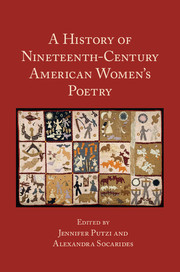Book contents
- Frontmatter
- Contents
- List of Illustrations
- List of Contributors
- Acknowledgments
- Introduction: Making History: Thinking about Nineteenth-Century American Women's Poetry
- PART I 1800–1840, AMERICAN POESIS AND THE NATIONAL IMAGINARY
- PART II 1840–1865, UNIONS AND DISUNIONS
- PART III 1865–1900, EXPERIMENT AND EXPANSION
- 17 Women Poets and American Literary Realism
- 18 Verse Forms
- 19 Braided Relations: Toward a History of Nineteenth-Century American Indian Women's Poetry
- 20 Frances Harper and the Poetry of Reconstruction
- 21 “hear the bird”: Sarah Piatt and the Dramatic Monologue
- 22 Women Writers and the Hymn
- 23 Women Poets, Child Readers
- 24 Emma Lazarus Transnational
- 25 The Creation of Emily Dickinson and the Study of Nineteenth-Century American Women's Poetry
- Suggested Further Reading
- Index
18 - Verse Forms
from PART III - 1865–1900, EXPERIMENT AND EXPANSION
Published online by Cambridge University Press: 21 January 2017
- Frontmatter
- Contents
- List of Illustrations
- List of Contributors
- Acknowledgments
- Introduction: Making History: Thinking about Nineteenth-Century American Women's Poetry
- PART I 1800–1840, AMERICAN POESIS AND THE NATIONAL IMAGINARY
- PART II 1840–1865, UNIONS AND DISUNIONS
- PART III 1865–1900, EXPERIMENT AND EXPANSION
- 17 Women Poets and American Literary Realism
- 18 Verse Forms
- 19 Braided Relations: Toward a History of Nineteenth-Century American Indian Women's Poetry
- 20 Frances Harper and the Poetry of Reconstruction
- 21 “hear the bird”: Sarah Piatt and the Dramatic Monologue
- 22 Women Writers and the Hymn
- 23 Women Poets, Child Readers
- 24 Emma Lazarus Transnational
- 25 The Creation of Emily Dickinson and the Study of Nineteenth-Century American Women's Poetry
- Suggested Further Reading
- Index
Summary
Those who write about mid- to late-nineteenth-century American poetry tend to say very little about verse forms or about formal characteristics of verse, yet it is widely accepted that the modernist poetry of the 1910s differs strikingly from its nineteenth-century predecessors in its forms. Consequently, understanding the shifting preferences for particular verse forms from the mid- to late nineteenth century provides useful information for understanding both late-nineteenth-century taste and the beginnings of modernist poetry in the United States. At stake is not just the transition from metered to free verse but a more basic conception of the poetic line and poetic rhythms. This essay focuses on a few elements of formal practice that shift during this period and on ways that some women poets manipulated syntax and rhythm within metered forms anticipating the more idiomatic rhythms of modernist poetry.
No change in a period's formal preferences or practices occurs at a particular moment. As Christopher Hager and Cody Marrs suggest in “Against 1865,” there are no simple dividing lines or sharp moments of transition in uses of literary form. In the nineteenth century, many poets wrote through more than one literary era, as scholars typically delimit them: the 1840s and 1850s, the Civil War, the late nineteenth-century, and early modernism. Nonetheless, one can distinguish some shifts in aesthetic preferences and formal practices between the 1860s and the 1890s.
My perception of these changes is based upon years of reading in this period and, for the context of this essay, primarily upon the poetry collected in two anthologies from the second half of the nineteenth century, one early twentieth-century anthology that adheres primarily to late nineteenth-century verse norms, and two late twentieth-century anthologies: Ralph Waldo Emerson's Parnassus: An Anthology of Poetry (1874); Edmund C. Stedman's An American Anthology, 1797–1900 (1900); Bliss Carman's Oxford Book of American Verse (1927); John Hollander's American Poetry: The Nineteenth Century (1993); and Paula Bernat Bennett's Nineteenth-Century American Women Poets: An Anthology (1998). These texts provide a relatively thorough survey of the period and give a surprisingly consistent sense of what is valued in poetry written between the late 1860s and 1900. Each of these anthologies also includes a large number of poems by women. Emerson's and Stedman's anthologies were the most influential of the second half of the century.
- Type
- Chapter
- Information
- A History of Nineteenth-Century American Women's Poetry , pp. 298 - 312Publisher: Cambridge University PressPrint publication year: 2016



